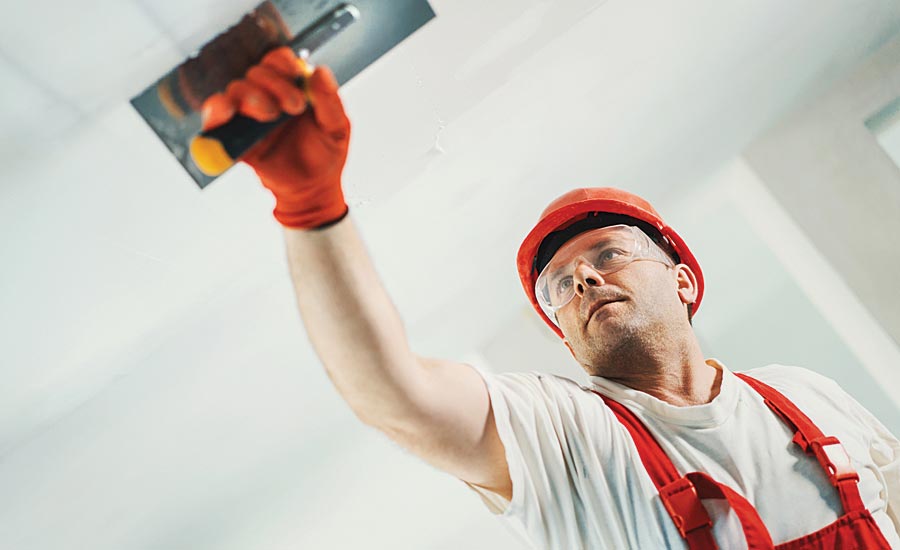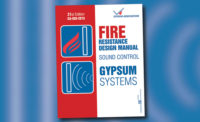It’s in the Codes
The Gypsum Association is the center of technical expertise for the gypsum industry. The public relies on the GA to provide authoritative and impartial advice to consumers as well as design and construction professionals. After all, gypsum panel products are all around us, used in nearly every built structure.
While it is true that gypsum wallboard is considered relatively easy to install and provides a smooth, durable, readily finished surface for walls and ceilings, wallboard isn’t specified in more than 97 percent of buildings because of that fact alone. Rather, drywall plays an extremely important role in offering passive fire-resistance. For this reason, the use of gypsum wallboard is mandated by the building codes, which reference the Gypsum Association’s GA-600 Fire-Resistance and Sound Control Design Manual as a source of tested assemblies for the fire-rated construction of walls, ceilings and etc.
About the Questions
The GA receives technical calls and emails every day. Most of these questions are answered by reference to the GA-600 Manual or one of more than thirty publications we offer free on our website. Our publications provide the best practices and guidance on everything from handling and storage of wallboard to its specification and proper installation. Despite the plethora of information the GA and its member companies strive to create and maintain, we occasionally get a question that is beyond the scope of any of these documents.
When a question relates to the passive fire-resistance that makes gypsum panel products a key building material, it is important to think through the situation very carefully. Knowledge of the building code, as well as a thorough understanding of both gypsum’s natural fire-resistive properties and the limitations of them, is paramount when addressing these questions.
An Example
A recent call is a case in point. In this instance, a developer built a core and shell building under the pertinent building permit and code criteria, not necessarily knowing the final occupancy requirements. Anticipating some type of cooking on site, the design professional associated with the core and shell project, specified a grease duct enclosed with a two-hour fire-rated shaft assembly. The core and shell passed inspection.
When the time arrived for tenant fit out, a separate permit was issued and the same grease duct failed to pass inspection. This happened because the intended use of the facility was now a bakery and grill. A type-1 hood and attached exhaust grease duct operating between 12 and 14 hours daily at approximately 400-500 degrees Fahrenheit would likely compromise the gypsum shaft enclosure. The inspector requested that the shaft be provided with additional thermal protection to protect the gypsum board from sustained temperatures in excess of 125 degrees Fahrenheit.
Slow it Down
Gypsum is approximately 21 percent by weight chemically combined water, the chemical formula being CaSO4·2H2O. When exposed to high heat, wallboard’s gypsum core does not burn; it releases the combined water in the form of steam in a process called calcination. In a fire situation, calcination makes gypsum panels great fire-resistive materials—the energy of the fire heats up and drives off this water. As a result, the energy in the form of hot gases, flames, etc. cannot penetrate the wallboard until the water is gone completely and the panel product crumbles. Under normal circumstances, the installed system would be expected to fail after two hours of exposure, providing time for occupants to escape and even for firefighters to work on saving the rest of the structure.
Why is Temperature so Important?
Regularly hitting 125 degrees Fahrenheit marks the beginning of an unforeseen condition. What was code compliant in a core and shell building was no longer acceptable given the tenant’s proposed use, which is something a well-experienced and educated code official recognized. Under normal conditions, the installed duct and enclosure would provide 2-hour passive fire-resistance. However, 12 or more hours of 400 to 500 degrees Fahrenheit, per day, creates a situation beyond the capacity of the 2-hour rated assembly.
When a panel system is exposed to temperatures above 125 degrees Fahrenheit for extended periods, calcination will begin to occur even in the absence of flames. The calcination may be slower, but water will start to be driven off immediately. As a result, the board will be less effective as a fire-resistive barrier. This means it is highly likely the assembly will not perform as intended in a fire event. After all, if a fire were to occur, there would be less water to drive off. The system could fail prematurely risking human life and property. The second building inspector, knowing the intended use of the space, wisely requested a modification to the system so it would be capable of performing under the intended circumstances.
The remedy is to insulate the duct and provide protection to the assembly, ideally keeping it below the 125 degrees Fahrenheit mark. A commonly recognized method for preventing the gypsum panel from heating up and compromising the system’s integrity is to wrap the duct in an insulating material—a “duct wrap”—rated for the application. When building the assembly, wrapping the duct is usually inexpensive and easy to do. Unfortunately, in this case, the initial core and shell team didn’t account for all possibilities. The duct enclosure needed to be removed, the wrap installed and the enclosure rebuilt.
The Design Aesthetic
Fire-resistive duct enclosures always provide some unique and challenging design and construction scenarios, even when unforeseen conditions do not present themselves. The code specifies that fire-resistive enclosures around duct assemblies be symmetrical (i.e. the inside of any one plane must be identical to the exterior of the same plane). The intent is to provide the same degree of restriction regardless of whether the fire is on the inside or outside of the enclosure. Of course, if a system is asymmetric but tested and certified both ways and passes the required fire-resistance criteria, it is acceptable. Too often, none of these requirements are met.
When designing the enclosure using tested wall or ceiling assemblies as the basis of design, bear in mind that systems designed and tested for vertical surfaces cannot be used on the horizontal plane of the enclosure—just as full wall systems cannot be arbitrarily used in floor-ceiling applications. Both the vertical and horizontal subsystems must be built as tested.
When designing the system to provide duct enclosure, supports must be tied exactly as shown in the drawings for the system. If a system design is adapted from a tested wall or floor-ceiling assembly, the built structure must accurately reflect the drawings for the full tested assembly, including correctly sized structural members, spacing and fasteners. Downsizing a structural member could result in premature failure of the duct assembly, leading to a higher risk of life and building loss.
Duct enclosures made with gypsum panel products can and are built and used successfully every day. Understanding the end use of the duct, the design considerations and the code criteria are all important to correctly design and build these assemblies. Given the challenges associated with duct enclosures and the importance of these systems, should the slightest question or concern arise, consulting with a fire design engineer may be a good idea when approaching ducts.





Report Abusive Comment